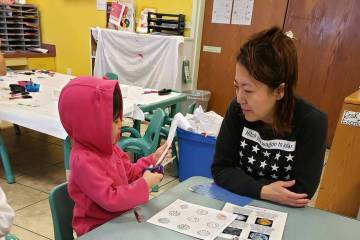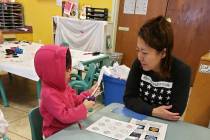CCSD roundtable highlights another district problem: engaging parents
The auditorium at Chaparral High School was set up to accommodate 430 people on Thursday.
But only about 60 parents, students or teachers — not counting members of the media and event staff — showed up to discuss the Clark County School District’s draft policy aimed at preventing improper staff-student relationships.
Given the issue’s prominence — 13 employees have been arrested and accused of sexual misconduct with students since July — where were the parents?
Lackluster parent involvement is nothing new for the district, although certain hot-button topics occasionally draw a crowd.
“I’m not blaming parents,” School Board President Deanna Wright said. “I’m just saying we have for years continued to try to work with the media, social media, online presence, all kinds of things, and we just can’t seem to be able to get parents’ attention.”
Take, for example, the annual districtwide surveys sent home this school year: Parents completed and returned 21,906 of them, according to the district’s Pledge of Achievement website. That’s slightly less than 7 percent of the roughly 321,000 students in the district.
Another indicator of parent engagement, or lack thereof: voting on standard student attire at schools.
The required threshold is so low — just 10 percent of the surveys need to be returned to make a decision — that in some cases, a small group of parents decides the wardrobe.
That was the case at McCall Elementary in North Las Vegas, where 200 ballots were sent home this spring. The total vote was 15-6.
Certainly there are still active parents in the district, as well as engaged parent groups such as Hope for Nevada.
Diane Adams, who sat quietly in the auditorium on Thursday, listening to the roundtable discussion, is one such parent.
“I never miss a meeting,” said Adams, a member of Chaparral’s school organizational team.
She said she wasn’t really surprised at the low parent turnout. If just a few parents show up to school team or Parent Advisory Committee meetings, she said, that is a good showing.
One reason for the district’s low involvement could be the high percentage of low-income families in Clark County. About 64 percent of students were eligible for free or reduced-price lunch as of May 31, according to the district.
Research suggests that a family’s socioeconomic status affects their level of engagement in their child’s education.
“Generally, the evidence demonstrates that the level of parental involvement is linked to the class position of the parents and to the social and cultural resources that social class yields in American society,” sociologist Annette Lareau wrote in a 1987 study. “By definition, the educational status and material resources of parents increase with social class.”
Lareau compared parental involvement in two schools in a working-class and upper-middle class neighborhood. She found more upper-middle class parents attended formal school events than parents from the working-class school.
That might be contribute to CCSD’s low parent engagement, but it’s not the whole story. Nor can it be attributed to a lack of effort by district officials, Wright said.
“I think that we try really hard,” she said. “I think that as a district, we do honest-to-goodness as much as we could possibly do. … Parents have just got a lot going on.”
Contact Amelia Pak-Harvey at apak-harvey@reviewjournal.com or 702-383-4630. Follow @AmeliaPakHarvey on Twitter. On Education appears every other Saturday.
RELATED
Parents, teachers clash at CCSD meeting to address sexual misconduct






















